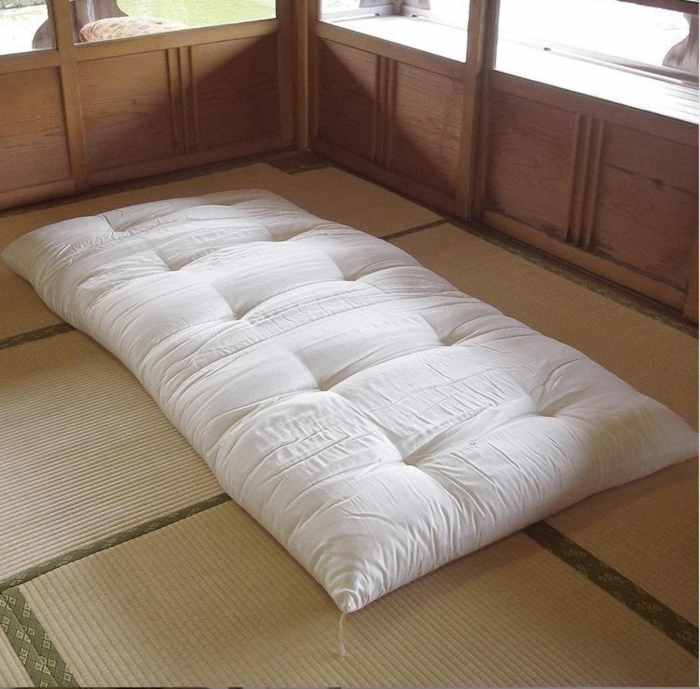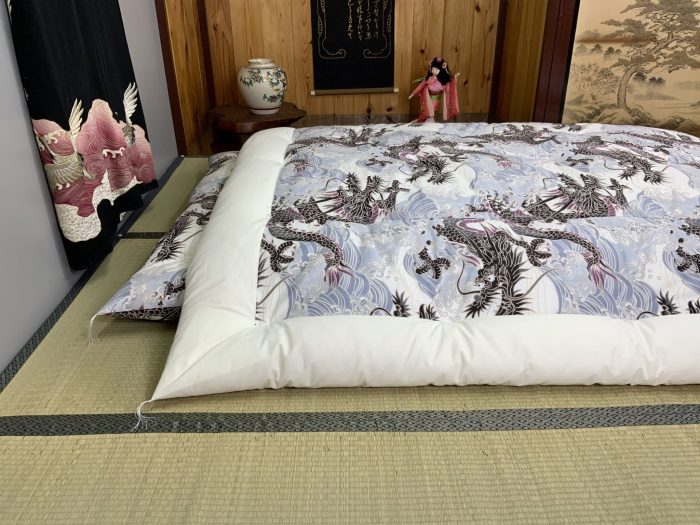Unveiling the timeless allure of Japanese futons, this comprehensive guide invites you on a journey through their rich history, meticulous design, and versatile applications in modern living. Prepare to immerse yourself in a world where comfort, tradition, and style harmoniously intertwine.
From their humble origins to their profound cultural significance, Japanese futons have left an enduring mark on the tapestry of Japanese society. Discover the secrets behind their traditional construction, the diverse materials employed, and the health benefits associated with sleeping on these remarkable bedding essentials.
Japanese Futon

Futons, a traditional Japanese bedding system, have played a significant role in Japanese culture and daily life for centuries. Their unique design and historical significance make them an integral part of Japanese homes and provide a comfortable and convenient sleeping experience.
Origins and Historical Significance
The origins of futons can be traced back to the Nara period (710-794 AD) when they were used as bedding by Buddhist monks. These early futons were simple, consisting of a layer of cotton or wool batting covered with a thin cloth.
Over time, futons became more elaborate, with the addition of multiple layers of batting and decorative covers. By the Edo period (1603-1868), futons had become an essential part of Japanese households, used by people of all social classes.
Japanese futons are traditional bedding that offer a firm and supportive sleeping surface. For those seeking a modern twist on this classic, consider the koala mattress . Its unique construction combines the comfort of a futon with the support of a memory foam mattress, providing the best of both worlds.
While the koala mattress offers a more contemporary sleeping experience, it complements the traditional aesthetic of Japanese futons, making it a perfect blend of old and new.
Traditional Design Elements
Traditional Japanese futons are typically made of natural materials such as cotton, wool, or silk. The batting is usually made of multiple layers, with the thickness and density varying depending on the desired level of firmness. The cover is typically made of a durable fabric such as cotton or hemp and is often decorated with traditional Japanese patterns.
Futons are typically placed on a tatami mat, a woven straw mat that provides a firm and supportive base. The futon is then covered with a thin sheet or blanket for warmth.
Cultural Importance
Futons hold great cultural significance in Japan. They are not only used for sleeping but also for a variety of other purposes, such as seating, meditation, and even as a guest bed. Futons are also often used in traditional Japanese tea ceremonies and other cultural events.
The use of futons is closely tied to the Japanese concept of wabi-sabi, which emphasizes the beauty of imperfection and the acceptance of change. Futons are often seen as a symbol of simplicity, modesty, and the interconnectedness of all things.
The Benefits and Uses of Japanese Futons
Japanese futons are versatile and offer numerous benefits, making them a popular choice for sleeping, seating, and meditation. Their unique construction provides health advantages and enhances the aesthetics of any room.
Health Benefits
Sleeping on a futon can improve posture, reduce back pain, and alleviate joint discomfort. The firm yet supportive surface aligns the spine and promotes proper blood circulation. The natural materials used in futons, such as cotton and wool, are breathable and hypoallergenic, creating a comfortable and healthy sleep environment.
Practical Uses
Futons are incredibly versatile and can be used for various purposes beyond sleeping. They can be folded and stored easily, making them ideal for small spaces or guest rooms. When used as seating, futons provide a comfortable and cozy spot for relaxation or entertaining guests.
They can also be placed on the floor for meditation, creating a serene and grounding space.
Aesthetic Appeal
Japanese futons come in a wide range of fabrics and colors, allowing them to complement any decor style. Their simple and elegant designs add a touch of Japanese minimalism to any room. The natural materials and traditional craftsmanship of futons create a unique and inviting ambiance.
Choosing the Right Japanese Futon

Choosing the right Japanese futon is essential for a comfortable and restful sleep. With various types of futons available, it’s crucial to consider factors such as materials, sizes, and firmness levels to find the perfect fit for your needs.
The Japanese futon, known for its comfort and versatility, can benefit greatly from a mattress protector . This additional layer safeguards the futon from spills, stains, and dust, extending its lifespan. Whether you’re enjoying a traditional tatami room or a modern bedroom, a mattress protector ensures that your Japanese futon remains pristine and inviting for restful nights.
When selecting a futon, it’s important to consider your personal preferences and sleeping habits. Different materials, such as cotton, wool, and latex, offer varying levels of comfort and support. The size of the futon should also be appropriate for your height and sleeping position.
Lastly, the firmness level plays a significant role in ensuring a comfortable sleep, with softer futons suitable for side sleepers and firmer futons providing better support for back sleepers.
Materials, Japanese futon
Futons are typically made from natural materials like cotton, wool, and latex. Cotton futons are breathable and affordable, while wool futons provide warmth and moisture-wicking properties. Latex futons offer excellent support and durability, but they tend to be more expensive.
Japanese futons, traditional bedding known for their comfort and versatility, are often used as foldable mattresses. These mattresses can be easily rolled up and stored away when not in use, making them a great space-saving option. If you’re looking for a foldable mattress that combines traditional comfort with modern convenience, be sure to check out the foldable mattress collection.
These mattresses are made with high-quality materials and construction, ensuring a comfortable and restful night’s sleep. They’re also available in a variety of sizes and styles to fit your needs and preferences. So, whether you’re looking for a traditional Japanese futon or a modern foldable mattress, there’s sure to be an option that’s perfect for you.
Sizes
Japanese futons come in various sizes, including single, double, and queen. The size you choose should depend on your height and sleeping position. A single futon is suitable for individuals under 5’5″, while a double futon is recommended for those between 5’5″ and 6’2″.
Queen-sized futons are ideal for taller individuals or couples.
Firmness Levels
Futons come in different firmness levels, ranging from soft to firm. Soft futons are suitable for side sleepers as they provide ample cushioning. Medium-firm futons offer a balance of support and comfort, while firm futons provide excellent support for back sleepers.
Incorporating Japanese Futons into Modern Decor
Incorporating Japanese futons into modern decor can create a unique and stylish look. Futons are versatile pieces of furniture that can be used in a variety of ways, from sleeping to seating to lounging. They are also relatively affordable and easy to care for, making them a great option for budget-minded shoppers.
Using Futons in Different Rooms of the House
Futons can be used in any room of the house, but they are especially well-suited for bedrooms, living rooms, and home offices. In bedrooms, futons can be used as a bed, a guest bed, or a daybed. In living rooms, futons can be used as a sofa, a chaise lounge, or a spare bed.
In home offices, futons can be used as a desk chair, a meditation cushion, or a nap spot.
Creating a Harmonious and Inviting Space with Futons
When incorporating futons into your modern decor, it is important to consider the overall style of the room. Futons can be paired with a variety of other furniture styles, from traditional to contemporary. However, it is important to choose pieces that complement the futon’s simple and understated design.
In addition to furniture, you can also use accessories to create a harmonious and inviting space with futons. For example, you can add pillows, throws, and rugs to create a cozy and comfortable atmosphere. You can also use artwork and plants to add a touch of personality to the space.
DIY Japanese Futon Projects
Creating your own Japanese futon can be a fun and rewarding experience. With a few simple materials and tools, you can craft a comfortable and stylish futon that will last for years to come.
Materials and Tools
- 3 yards of cotton fabric (100% cotton is best)
- 2 yards of batting (100% cotton or wool)
- Needle and thread
- Sewing machine
- Scissors
- Measuring tape
- Ruler or yardstick
- Iron and ironing board
Optional
Decorative trim, buttons, or other embellishments
Step-by-Step Instructions
- Cut the fabric and batting to the desired size of your futon. The standard size for a Japanese futon is 5 feet by 6 feet.
- Layer the fabric and batting together, with the fabric on the top and bottom and the batting in the middle.
- Pin the layers together around the edges.
- Sew around the edges of the futon, using a 1/2-inch seam allowance.
- Turn the futon right side out and press it flat.
- Fold the futon in half lengthwise and then in half again widthwise.
- Sew the edges of the futon together along the folded edges, using a 1/4-inch seam allowance.
- Turn the futon right side out and press it flat.
Customization
You can customize your Japanese futon to match your personal style by choosing different fabrics, batting, and embellishments. For example, you could use a heavy-duty canvas fabric for a more durable futon, or a soft flannel fabric for a more comfortable futon.
You could also use a combination of different batting materials, such as cotton and wool, to create a futon that is both comfortable and supportive. And finally, you could add decorative trim, buttons, or other embellishments to give your futon a unique look.
Wrap-Up

As we conclude our exploration of Japanese futons, it is evident that these versatile寝具 have transcended their traditional roots to become a global symbol of comfort and style. Whether you seek a restful night’s sleep, a cozy seating solution, or a touch of Japanese elegance in your home décor, Japanese futons offer a myriad of possibilities.
Embark on your own futon journey today, incorporating these timeless treasures into your living spaces and experiencing the unique blend of tradition and modernity that they embody. Let Japanese futons elevate your daily life, bringing a touch of serenity, comfort, and aesthetic beauty to every moment.
Essential Questionnaire
What are the benefits of sleeping on a Japanese futon?
Japanese futons provide excellent back support, promote spinal alignment, and alleviate pressure points, contributing to improved sleep quality and reduced back pain.
How can I incorporate Japanese futons into my modern home décor?
Japanese futons seamlessly blend with various interior design styles. Use them as a bed frame, a sofa, or a floor cushion in your bedroom, living room, or home office, creating a harmonious and inviting space.
How do I care for my Japanese futon?
Regular airing and occasional sun exposure help maintain the freshness and longevity of your futon. Avoid excessive moisture and clean it professionally as needed.